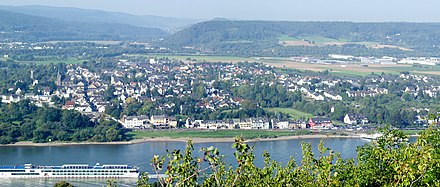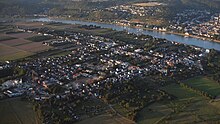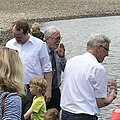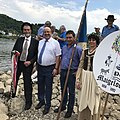Crib
|
Crib
City of Remagen
Coordinates: 50 ° 33 ′ 41 ″ N , 7 ° 15 ′ 57 ″ E
|
||
|---|---|---|
| Height : | 65 m above sea level NN | |
| Residents : | 3726 (December 31, 2018) | |
| Postal code : | 53424 | |
| Area code : | 02642 | |
|
Location of Kripp in Rhineland-Palatinate |
||
Kripp is one of six local districts and at the same time one of eight districts of the association-free city of Remagen in the district of Ahrweiler in the north of Rhineland-Palatinate . On December 31, 2018, the district had 3726 inhabitants.
history
Kripp was first mentioned in documents in 1474, when imperial troops observed the opposite city of Linz during the Burgundian War , the place Kripp was only heavily populated at the beginning of the 18th century . The first house was built in 1706 by the Linz citizen Johann Breuer, this year is the founding date of the place Kripp.
The name of the village can be traced back to the days of towing , as a feeding station ( crib ) was set up for the towing horses on the spot . Kripp was an important stopover for towing ships between Cologne and Koblenz. Towing means that you pull ships upstream with horses. The horses wore flaps on their left eyes to protect them from backlight reflected in the Rhine and from blindness.
The Caledonia was the first steamship that passed Kripp on November 13, 1817, because the Defiance had only made it to Cologne . When even more steamships were available and sailed on the Rhine, especially due to the expansion of the fleet by Haniel and Stinnes , the hauliers failed to understand the necessary structural changes and in 1848 shot at the steamships. A cannon was even used. However, none of the ships was sunk. The cannon can still be seen today as a monument to an indomitable will, or a “stubborn hostility to progress” on the Rhine on a pedestal near the ferry pier. The uprising also spread to other towing stations from Wesseling to Weißenthurm . It has also been handed down that the old crippers must have been "wild fellows" - corresponding complaints were brought to the authorities in Remagen .
Kripp flourished with the burning of bricks from clay , which has now been found and mined there. An entrepreneur from Italy took on the business and burned the bricks for a leather factory. He also paid the workers with bricks; of course only with the bad ones. The good bricks became the leather factory, which is still standing today, and the bad ones became the manger houses. The Roman Catholic Church of St. John Nepomuk was also built from crib bricks from 1900 to 1903 .
When the bricks were finally no longer burned, the workers were paid with schnapps and also with money they had made themselves. In the leather factory, built in 1905, up to 170 people found work.
When all the clay for the bricks was removed, the gravel bed underneath came to light. The manger also processed this business-mindedly and turned it into concrete . The Beton-Union is still there today.
The shoals of the herring-like fish called Feint , which returned every year up to around 1933, have had a direct impact on the naming and customs of Kripp until today. There is an abusive word about the Kripper from the surrounding towns: "Kripper Fente, rüch ens, wat se stinke" (in High German, for example: "Kripper Finte, smell how they stink"). So in 1951 the carnival society "Kripper Fente" was founded. On December 29, 1953, the ferry "Finte" was put into service - today out of service. In 1955 Friedel Valentin was the first carnival prince with a prince wearing a prince's uniform. In 1998 the carnival company "Kripper Fente KG" was founded as the successor to the "Kripper Fente".
The real success story of Kripp began with the discovery of the Maria-Luisen-Quelle, which was found during a flood through the appearance of small air bubbles. Kripp then became "Bad Kripp". A Kurhaus was formed. The federal highway 266 was expanded until the spring disintegrated in the 1950s . The water became impure and no longer edible, but remained the basis for the lemonade production by Quellen-Lehnig AG .
The bottling plants of two springs were given up. Due to the acute danger of collapse of the ruins in Quellenstrasse, the sidewalk is now closed. The industrial buildings are being reclaimed by nature and overgrown year after year by thicker carpets of blackberry tendrils and wild vines. Every spring at the time of the flood , the Ahr makes its way through the overgrown plots .
place
Kripp is divided into the upper and lower village, differentiated according to the altitude on the banks of the Rhine . Its landmark is the Kripper water tower (built in 1904), which is visible from afar and rises above the gardens and is a listed building.
The two bakeries for the supply of everyday goods are important for the population .
The B266 leads through the village and ends first on the banks of the Rhine. The ferry that carries travelers to Linz operates there . In the other direction leads B 266 into the Ahr valley where the steep, barren slate slopes wines in winzerischer are cultivated by hand. During the waiting time, travelers can buy a supply in the Weinkontor right next to the ferry dock.
For camping enthusiasts , Kripp is a household name at the Goldene Meile campsite , which is also well attended in winter . From the Rhine you can also see the former character of Kripp as a location for orchards .
To the volunteer fire department in case of flood to spare the building and displacing webs, a channel named was "Ingo-Wolf channel" created. In this way, supply and transport boats can, with the exception of so-called century floods, bring residents of the flood area and supplies “dry feet” to shore.
In addition to a primary school, there are two kindergartens in Kripp.
politics
District
Kripp is one of six districts in the city of Remagen. The district is politically represented by a local advisory board and a local mayor .
Local advisory board
The local advisory board consists of ten members who were elected in the local elections on May 26, 2019 in a personalized proportional representation, and the honorary mayor as chairman. According to the city's main statute of June 2019, twelve members are planned in the future.
The distribution of seats in the local advisory board:
| choice | SPD | CDU | Green | FBL | total |
|---|---|---|---|---|---|
| 2019 | - | 1 | 3 | 6th | 10 seats |
| 2014 | 2 | 4th | 1 | 3 | 10 seats |
| 2009 | 1 | 4th | 1 | 4th | 10 seats |
- FBL = Free Citizen List Kripp
Mayor
Axel Blumenstein (FBL) became the mayor of Kripp in mid-August 2019. In the direct election on May 26, 2019, he was elected for five years with 85.90% of the vote.
Blumenstein's predecessor Heinz-Peter Hammer (CDU) had held the office since 2004, but did not take up office again in 2019.
religion
- Catholic parish of St. Johannes Nepomuk Kripp
- Evangelical parish Martin Luther Church Kripp
Culture
- One of the annual highlights is the drive of straw bears as part of the annual carnival procession on Carnival Saturday.
On June 2, 2017 - for the first time in Rhineland-Palatinate - the official celebration of the annual allis shad stocking in the Rhine took place in Kripp. At the same time, around 200,000 allis shad larvae were released in the Ahr estuary. During the celebration, State Secretary Griese from the Rhineland-Palatinate Environment Ministry was proud to announce that the EU allis shad program, headed by Dr. Andreas Scharbert was crowned with success and for the first time a spawning area with hundreds of allis shad was discovered near Koblenz. During the celebration an allis shad exhibition of the Poller Heimatmuseum in cooperation with Poller Maigeloog with over 150 panels about allis shad and allis shad fishing in Cologne-Poll , on the Rhine, in Strasbourg , in Europe and in America was shown.
Attractions
- Old pump manger
- Catholic parish church of St. Johannes Nepomuk
- High water emergency chapel Kripp
- Water tower manger
- Rhine promenade Kripp
- Nature reserve estuary of the Ahr
- Ahr curve in front of the mouth
- A sculpture by Johannes Brus , which was erected as a station on the Remagen Sculpture Bank , reminds us of Kripp as an important towing station between Cologne and Koblenz . It shows a concrete boat and two bronze horses.
- Feint Fountain, as a reminder of the historical catch of feints in Kripp
- Maria-Luisen-Quelle
Sports
- Table tennis club Kripp
- Sports club 1946 Kripp eV
Association
The Bürger- und Heimatverein Kripp eV, chaired by Harry Sander, has dedicated itself to beautifying the appearance of Kripp as well as remembering the history of the source site. The association has left signatures in many places in Kripp. This includes the renovation and maintenance of the memorial for civilian victims of the Second World War from Kripp, the Fintebrunnen, the information boards in the village and the traditional celebrations on the square in the center of the village. In addition to the voluntary work for the ferry location, social gathering is a top priority in the association; this includes, for example, regular hiking days with excursions in the region. On June 2, 2017, he succeeded in bringing the official celebration of the annual allis shad stocking to Kripp in the Rhine.
Individual evidence
- ↑ a b without secondary residences ; Source: Residential statistics of the city of Remagen
- ↑ a b Main Statute of the City of Remagen. § 2 and 3. Remagen City Administration, June 24, 2019, accessed on July 25, 2020 .
- ^ Josef Siebertz: From the history of the Rhine ferry Linz-Kripp . In: 1100 years Linz am Rhein - Festival book for the 1100 year celebration . P. 275.
- ↑ http://www.geschichte-kripp.de/36.html
- ↑ http://www.kripper.de/43.html
- ↑ http://www.geschichte-kripp.de/18.html
- ↑ http://www.geschichte-kripp.de/35.html
- ↑ http://www.geschichte-kripp.de/66.html .
- ^ The Regional Returning Officer for Rhineland-Palatinate: Local Advisory Council election 2019 Kripp. Retrieved July 25, 2020 .
- ^ The Regional Returning Officer Rhineland-Palatinate: Local Advisory Board Election 2014 Kripp. Retrieved July 25, 2020 .
- ^ The Regional Returning Officer of Rhineland-Palatinate: Local Advisory Council election 2009 Kripp. Retrieved July 25, 2020 .
- ↑ Axel Blumenstein: First citizens' consultation hour. Press release. In: Blick Aktuell. Krupp Verlags GmbH, Sinzig, August 28, 2019, accessed on July 25, 2020 .
- ^ The Regional Returning Officer Rhineland-Palatinate: direct elections 2019. see Remagen, non-association municipality, first line of results. Retrieved July 25, 2020 .
- ^ Günther Schmitt: Heinz-Peter Hammer withdraws candidacy. In: General-Anzeiger. General-Anzeiger Bonn GmbH, October 20, 2018, accessed on July 25, 2020 .
- ↑ http://www.eifelzeitung.de/allgemein/tagesthemen/der-maifisch-kom-nach-rheinland-pfalz-154749/
- ↑ https://www.myheimat.de/koeln/natur/poller-maigeloog-mit-ausstellung-eingeladen-zu-maifischbesatz-2017-in-kripp-ahrmuendung-maifischsichtungen-am-oberrhein-d2816285.html
- ↑ May fish are supposed to return to the estuary of the Ahr. In: Blick Aktuell. Krupp Verlags GmbH, Sinzig, May 25, 2017, accessed on July 25, 2020 .
















